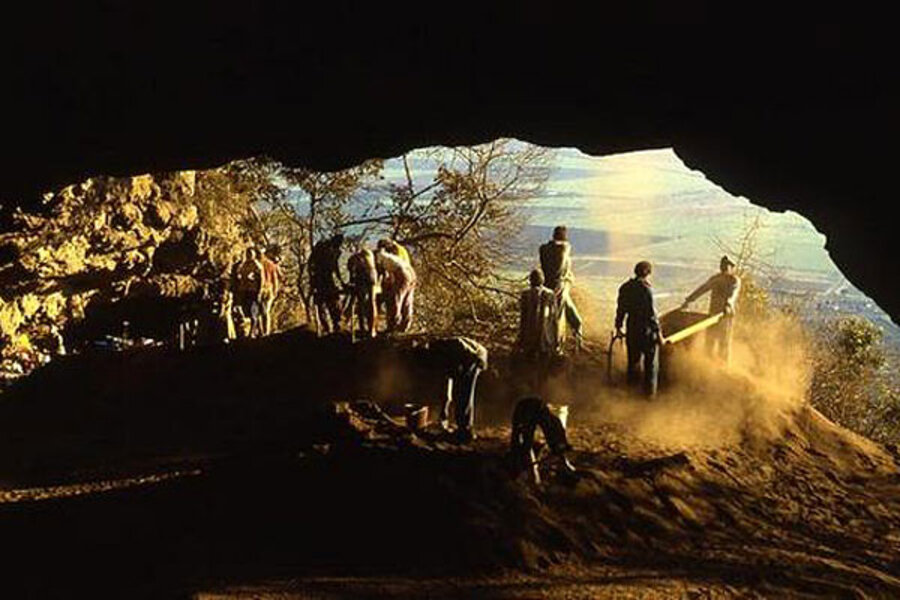Start date for human civilization moved back 20,000 years or so
Loading...
The late Stone Age may have had an earlier start in Africa than previously thought — by some 20,000 years.
A new analysis of artifacts from a cave in South Africa reveals that the residents were carving bone tools, using pigments, making beads and even using poison 44,000 years ago. These sorts of artifacts had previously been linked to the San culture, which was thought to have emerged around 20,000 years ago.
"Our research proves that the Later Stone Age emerged in South Africa far earlier than has been believed and occurred at about the same time as the arrival of modern humans in Europe," study researcher Paola Villa, a curator at the University of Colorado Museum of Natural History, said in a statement.
The Later Stone Age in Africa occurred at the same time as Europe's Upper Paleolithic Period, when modern humans moved into Europe from Africa and met the Neanderthals about 45,000 years ago.
"[T]he differences in technology and culture between the two areas are very strong, showing the people of the two regions chose very different paths to the evolution of technology and society," Villa said. [10 Mysteries of the First Humans]
Hints of culture
Traces of civilization have been found going back nearly 80,000 years in Africa, but these fragments — bone tools, carved beads — vanish from the archaeological record by about 60,000 years ago.
In fact, almost nothing is known about what happened in Southern Africa between 40,000 and 20,000 years ago, Villa and his colleagues wrote online today (July 30) in the journal Proceedings of the National Academy of Sciences. This gap makes it hard to link middle-Stone Age societies to the ones that came later.
The researchers brought the latest in dating technology to bear on a site on the border of South Africa and Swaziland called Border Cave. They found that a number of the artifacts in the cave were much older than expected. [See Amazing Cave Photos]
Ostrich eggshell beads, sharp bone points likely used for arrowheads, and notched bones were among the fragments of life dating back thousands of years before the San were thought to have emerged. One long-bone tool is decorated with a spiral incision that was then filled with red-clay pigment. A set of warthog or pig tusks shows signs of grinding and scraping. Other bones are marked with notches, as if they were used to keep a tally of something.
The researchers also found beads, several apparently deliberately blackened by fire, one dating back more than 38,000 years. A piece of wood associated with a stone with a hole through it was dated to about 35,000 years ago. The tool appears to be an early digging stick of the sort used by the later San people to unearth roots and termite larvae.
Oldest poison
The researchers also dated a lump of beeswax mixed with toxic resin that was likely used to haft, or attach, stone points to the shafts of arrows or spears. The beeswax dates to about 35,000 years ago, making it the oldest known example of beeswax being used as a tool.
Finally, researchers dated a thin wooden stick scarred with perpendicular scratches. A chemical analysis revealed traces of ricinoleic acid, a natural poison found in castor beans. It's likely that the stick was an applicator used to put poison on an arrow or spearheads, the archaeologists reported. At about 20,000 years old, the applicator marks the first use of poison ever discovered.
"The very thin bone points from the Later Stone Age at Border Cave are good evidence for bow and arrow use," Villa said. "The work by d'Errico and colleagues [published alongside Villa's group's report in the same journal] shows that the points are very similar in width and thickness to the bone points produced by San culture that occupied the region in prehistoric times, whose people were known to use bows and arrows with poison-tipped bone points as a way to bring down medium and large-sized herbivores."
The ancient dates help fill in a continuity gap of human civilization, said study researcher Lucinda Backwell, a researcher in palaeoanthropology at the University of the Witwatersrand in South Africa.
"The dating and analysis of archaeological material discovered at Border Cave in South Africa, has allowed us to demonstrate that many elements of material culture that characterize the lifestyle of San hunter-gatherers in southern Africa, were part of the culture and technology of the inhabitants of this site 44,000 years ago," Backwell said.
It seems plausible that these technologies arose 50,000 to 60,000 years ago in Africa and later spread to Europe, Villa said.
Follow LiveScience on Twitter @livescience. We're also on Facebook & Google+.
- Top 10 Things that Make Humans Special
- The Awá: Faces of a Threatened Tribe
- In Photos: Survival of an Ancient Civilization
Copyright 2012 LiveScience, a TechMediaNetwork company. All rights reserved. This material may not be published, broadcast, rewritten or redistributed.







